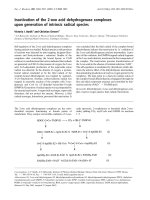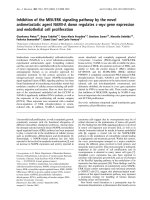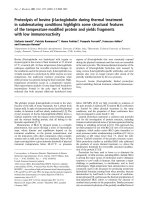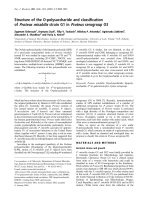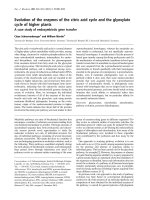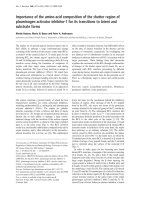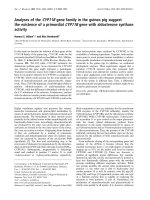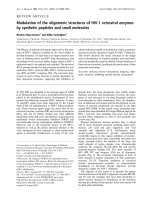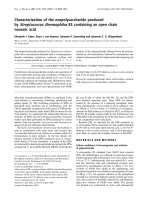Báo cáo y học: "Validation of the reshaped shared epitope HLA-DRB1 classification in rheumatoid arthritis" pptx
Bạn đang xem bản rút gọn của tài liệu. Xem và tải ngay bản đầy đủ của tài liệu tại đây (126.02 KB, 6 trang )
Open Access
Available online />Page 1 of 6
(page number not for citation purposes)
Vol 8 No 3
Research article
Validation of the reshaped shared epitope HLA-DRB1
classification in rheumatoid arthritis
Laëtitia Michou
1
, Pascal Croiseau
2
, Elisabeth Petit-Teixeira
1
, Sophie Tezenas du Montcel
2,3
,
Isabelle Lemaire
1,4
, Céline Pierlot
1
, José Osorio
1
, Wafa Frigui
1
, Sandra Lasbleiz
1,5
,
Patrick Quillet
1,4
, Thomas Bardin
1,5
, Bernard Prum
6
, Françoise Clerget-Darpoux
2
,
François Cornélis
1,5,7
and the European Consortium on Rheumatoid Arthritis Families
1
GenHotel-EA 3886, University Evry-ParisVII Medical School, Member of the Autocure European Consortium, Evry-Genopole, France
2
INSERM U 535, University Paris XI, Villejuif, France
3
Service de Biostatistiques et d'Information Médicale, CHU Pitié-Salpétrière, Assistance Publique-Hôpitaux de Paris, Paris, France
4
Laboratoire de Biologie, Centre Hospitalier Sud Francilien, Corbeil-Essonne, France
5
Unité de Génétique Clinique Adulte, Hôpital Lariboisière, Assistance Publique-Hôpitaux de Paris, Paris, France
6
Laboratoire Statistique et Génome, Evry-Genopole, France
7
Consultation de Génétique Adulte, Centre Hospitalier Sud Francilien, Evry-Corbeil, France
Corresponding author: Laëtitia Michou,
Received: 7 Feb 2006 Revisions requested: 10 Mar 2006 Revisions received: 26 Mar 2006 Accepted: 29 Mar 2006 Published: 28 Apr 2006
Arthritis Research & Therapy 2006, 8:R79 (doi:10.1186/ar1949)
This article is online at: />© 2006 Michou et al.; licensee BioMed Central Ltd.
This is an open access article distributed under the terms of the Creative Commons Attribution License ( />),
which permits unrestricted use, distribution, and reproduction in any medium, provided the original work is properly cited.
Abstract
Recently, we proposed a classification of HLA-DRB1 alleles that
reshapes the shared epitope hypothesis in rheumatoid arthritis
(RA); according to this model, RA is associated with the RAA
shared epitope sequence (72–74 positions) and the
association is modulated by the amino acids at positions 70 and
71, resulting in six genotypes with different RA risks. This was
the first model to take into account the association between the
HLA-DRB1 gene and RA, and linkage data for that gene. In the
present study we tested this classification for validity in an
independent sample. A new sample of the same size and
population (100 RA French Caucasian families) was genotyped
for the HLA-DRB1 gene. The alleles were grouped as proposed
in the new classification: S
1
alleles for the sequences A-RAA or
E-RAA; S
2
for Q or D-K-RAA; S
3D
for D-R-RAA; S
3P
for Q or R-
R-RAA; and X alleles for no RAA sequence. Transmission of the
alleles was investigated. Genotype odds ratio (OR) calculations
were performed through conditional logistic regression, and we
tested the homogeneity of these ORs with those of the 100 first
trio families (one case and both parents) previously reported. As
previously observed, the S
2
and S
3P
alleles were significantly
over-transmitted and the S
1
, S
3D
and X alleles were under-
transmitted. The latter were grouped as L alleles, resulting in the
same three-allele classification. The risk hierarchy of the six
derived genotypes was the same: (by decreasing OR and with
L/L being the reference genotype) S
2
/S
3P
, S
2
/S
2
, S
3P
/S
3P
, S
2
/L
and S
3P
/L. The homogeneity test between the ORs of the initial
and the replication samples revealed no significant differences.
The new classification was therefore considered validated, and
both samples were pooled to provide improved estimates of RA
risk genotypes from the highest (S
2
/S
3P
[OR 22.2, 95%
confidence interval 9.9–49.7]) to the lowest (S
3P
/L [OR 4.4,
95% confidence interval 2.3–8.4]).
Introduction
The pathogenesis of rheumatoid arthritis (RA) is multifactorial,
involving both genetic and environmental factors. Although
associations between some HLA-DRB1 alleles and RA were
reported nearly three decades ago, the biological mechanism
underlying this association remains unknown. The presence of
the RAA sequence at positions 72–74 of the HLA-DR β-chain
molecule for all HLA-DRB1 alleles known to be associated
with RA led to the shared epitope (SE) hypothesis [1]. This
hypothesis received support from numerous case-control
association studies in both Caucasian and non-Caucasian
populations. However, studies testing the SE hypothesis have
rejected this simple model, which stipulates that each SE
allele confers the same risk [2-5].
CI = confidence interval; OR = odds ratio; RA = rheumatoid arthritis; SE = shared epitope.
Arthritis Research & Therapy Vol 8 No 3 Michou et al.
Page 2 of 6
(page number not for citation purposes)
Recently, Tezenas du Montcel and coworkers proposed a
model of the SE component in RA [6]. Those investigators
reconsidered the SE hypothesis and generated a new classi-
fication of HLA-DRB1 alleles, based on their investigation
using the MASC (Marker Association Segregation Chi
Square) method [7], which was conducted in 100 trio families
(one case and both parents) and 132 index cases from
affected sibling pair families, all from the French Caucasian
population. They proposed that the risk for developing RA
depends on whether the RAA sequence occupies positions
72–74 and, if this is the case, on the amino acids at positions
71 and 70. For those RAA alleles, lysine (K) at position 71 con-
ferred the highest risk, arginine (R) an intermediate risk, and
alanine (A) or glutamic acid (E) the lowest risk. Glutamine (Q)
or arginine (R) at position 70 conferred greater risk than did
aspartic acid (D). This resulted initially in five allele groups,
which were simplified to three allele groups defining six geno-
types with different RA risks. This study was the first to model
the HLA component in RA taking into account both associa-
tion and linkage data, resulting in a reshaped SE hypothesis.
Here, we tested this classification for validity by replication in
a new, independent sample of 100 French Caucasian trio fam-
ilies, evaluating the risk hierarchy of the proposed classifica-
tion for homogeneity with that of the initial sample.
Materials and methods
Study design and study population
An association study using conditional logistic regression was
performed to investigate the hierarchy of risks associated with
HLA-DRB1 genotypes in an independent sample of trio fami-
lies. The new independent sample (sample B), similar to that
used to generate the new classification (sample A), included
100 trio families (one RA patient and both parents) of French
Caucasian origin (criteria fulfilled for each of the four grandpar-
ents). DNA from all of the trio families included in samples A
and B was collected between 1994 and 1998, as were initial
clinical characteristics of the RA index patients. RA diagnosis
met the 1987 American College of Rheumatology (formerly,
the American Rheumatism Association) criteria [8]. All individ-
uals provided written informed consent, and the study was
approved by the Hospital Bicêtre ethics committee (Kremlin-
Bicêtre, Assistance Publique-Hôpitaux de Paris).
Clinical characteristics were updated in 2001 and 2002 for
sample A and in 2004 for sample B. Four RA index patients in
sample A and two RA index patients in sample B died between
the time of DNA collection and the present study. The updated
clinical characteristics of sample B were similar to those of
sample A (the initial sample): 90% of RA patients in sample B
were female versus 87% in sample A; the mean (± standard
error) age at RA onset was 31 ± 9 years versus 32 ± 10 years;
the mean (± standard error) disease duration was 16 ± 8
years versus 18 ± 7 years; erosions were present in 79% ver-
sus 90%; 76% were positive for serum rheumatoid factor ver-
sus 81%; and nodules were present in 19% versus 31%.
Rheumatoid factor was considered positive when there was at
least one positive rheumatoid factor finding during the course
of the disease, as determined using latex fixation, Waaler Rose
assay, or laser nephelometry.
HLA-DRB1 genotyping
Blood samples were collected for DNA extraction and geno-
typing. HLA-DRB1 typing was performed using the polymer-
ase chain reaction-sequence specific primer (SSP) method
using Dynal Classic SSP DR low resolution and the Dynal
Classic high resolution SSP (Dynal Biotech, Lake Success,
NY, USA) for subtyping of HLA-DRB1*01, *04, *11, *13 and
*15 alleles. Sequencing of exon 2 of HLA-DRB1 was per-
formed for all four HLA-DRB1*04 alleles, ambiguous with the
Dynal Classic method. HLA-DRB1 allele frequencies of con-
trol genotypes (obtained by combining untransmitted parental
alleles for each family) were similar between samples and were
comparable to the allele frequencies reported for the French
population in the 11th Histocompatibility Workshop [9].
HLA-DRB1 allele classification
HLA-DRB1 alleles were divided in two groups according to
the presence or absence of the RAA sequence at positions
72–74, defining S and X alleles (Table 1). The S alleles were
then subdivided into three categories, according to amino acid
at position 71, as follows: S
1
when an alanine or a glutamic
acid was present at position 71 (A-RAA or E-RAA sequences;
A-RAA alleles were too infrequent not to be pooled, as
described previously [6]); S
2
when a lysine was present (K-
RAA sequence); and S
3
when an arginine was present at posi-
tion 71 (R-RAA sequence). Then S
3
alleles were subdivided
according to amino acid at position 70: S
3D
alleles encoding
the D-R-RAA sequence and S
3P
alleles encoding the Q or R-
R-RAA sequence. Because the S
2
alleles had either Q or D at
position 70, they had – by this '70-71-72/74' nomenclature –
the Q or D-K-RAA sequence.
Statistical analysis
We first investigated transmission of the five alleles (S
1
, S
2
,
S
3D
, S
3P
and X) using a χ
2
test with one degree of freedom for
each allele. Alleles with significant over-transmission from het-
erozygous parents to RA patients (>50%) are linked to and
associated with RA. Alleles with significant under-transmission
(<50%) exhibit no RA association and could be pooled for fur-
ther analysis.
Then, for each genotype 'I', the odds ratio 'ORi' relative to a ref-
erence genotype and 95% confidence interval (CI) were cal-
culated by conditional logistic regression. In this analysis, the
genotypes observed for the RA patients were conditioned to
the parents' genotypes [10,11]. The RA patient genotypes
were compared using a likelihood ratio test with the pseudo-
controls (i.e. the three other genotypes that could be formed
by parental gametes). Given reference genotype with baseline
Available online />Page 3 of 6
(page number not for citation purposes)
risk termed β
0
, each OR β
i
(i = 1 n) was estimated by the
maximization of the log likelihood (L):
ln(L) = β
0
+ β
1
X
1
+ β
2
X
2
+ + β
n
X
n
Where Xi is an indicator taking value 1 for genotype 'i' and 0
for the other genotypes, and β
i
= log ORi, with β
0
being the
baseline risk for reference genotype. Likelihood computations
and estimation were performed using the program developed
by Clayton [12]. All the results were produced using STATA
software (David Clayton, Cambridge, UK).
In case of replication of the genotype risk hierarchy, a homo-
geneity test on genotypic ORs was performed between the
two trio family samples. In this test, we considered that, if
homogeneity was present, then Q = -2(ln(maxL
AB
) - (ln(maxL
A
)
+ (ln(maxL
B
)))) would follow a χ
2
distribution with n degrees of
freedom (n being the number of β
i
s estimated). L
A
, L
B
and L
AB
were the maximum likelihood over β
i
in sample A, sample B and
pooled samples A and B, respectively.
If homogeneity between the two samples was confirmed, then
the classification was considered validated, and OR (95% CI)
were estimated by conditional logistic regression on the entire
sample (samples A and B combined).
Results
Test of the shared epitope allele classification in the new
independent sample
We first observed significant over-transmission of S
2
alleles
(53 S
2
alleles transmitted versus 33.5 alleles expected; P =
1.9 × 10
-6
) and of S
3P
alleles (47 S
3P
alleles transmitted versus
33.5; P = 0.001), as was previously reported [6]. S
1
, S
3D
and
X alleles were under-transmitted: 28 S
1
alleles were transmit-
ted versus 40 expected (P = 0.007), 11 S
3D
alleles was trans-
mitted versus 18 expected (P = 0.02), and 30 X alleles were
transmitted versus 44 expected (P = 0.003). These three low-
risk alleles (S
1
, S
3D
and X) were pooled as L alleles, as
reported previously. Thus, in subsequent analyses we consid-
ered only three alleles (S
2
, S
3P
and L alleles), with six corre-
sponding genotypes.
The conditional logistic regression analysis provided the fol-
lowing hierarchy of genotype risks: S
2
/S
3P
and S
2
/S
2
geno-
types were associated with greatest risk for RA, with ORs of
19.5 and 18.0, respectively; these were followed by S
3P
/S
3P
,
S
2
/L and S
3P
/L genotypes, with ORs of 8.7, 5.3 and 3.1,
respectively (with the reference genotype being L/L; Table 2).
This hierarchy was precisely the same as observed previously
[6].
Results of the homogeneity test
The homogeneity test on genotypic ORs between the new
sample and the initial one resulted in a χ
2
with five degrees of
freedom of 1.3 (P = 0.80). Because this test was not statisti-
cally significant, we considered the two samples to be homo-
geneous and the new classification to be valid.
Odds ratio estimation on the pooled sample of 200 trio
families
Because the two samples were homogeneous, ORs were esti-
mated, by conditional logistic regression, for the pooled sam-
ple of 200 trio families (Table 3).
Table 1
Classification of HLA-DRB1 alleles
Allele classification Amino acid sequence at positions 70–74 HLA-DRB1 alleles
S
1
D-E-RAA *0103, *0402, *1102, *1103, *1301, *1302, *1304, *1323
Q-A-RAA *15
S
2
Q-K-RAA *0401
D-K-RAA *1303
S
3D
D-R-RAA *1101, *1104, *12, *1305, *1306, *1325, *1422, *16
S
3P
Q-R-RAA *0101, *0102, *0404, *0405, *0408
R-R-RAA *1001
X Q-K-RGR *03
Q-R-RAE *0403, *0407, *0411
D-R-RGQ *07
D-R-RAL *08
R-R-RAE *0901, *1401, *1404
This classification of alleles, observed in our samples, is according to the amino acid sequence at positions 70–74, as described by Tezenas du
Montcel and coworkers [6].
Arthritis Research & Therapy Vol 8 No 3 Michou et al.
Page 4 of 6
(page number not for citation purposes)
Discussion
In the present study we validated the classification of HLA-
DRB1 SE alleles in RA proposed by Tezenas du Montcel and
coworkers [6]. This is the first study to validate a model of the
HLA-DRB1 component of RA based on the SE hypothesis [1],
with detailed investigation of the SE through the contribution
of SE single amino acids to RA susceptibility, taking into
account both linkage and association data. This work results
in a risk genotype hierarchy, for which we provide OR esti-
mates. The ORs were obtained exclusively from trio families,
providing unbiased estimates for the sample investigated; this
contrasts with estimations derived from case-control studies,
for which the population matching between cases and con-
trols can be questioned.
Further studies in other Caucasian and non-Caucasian popu-
lations are required to validate this new classification fully and
investigate population-specific effects. The ORs reported here
relate to relatively early onset RA, as is found in trio families.
Because the mean duration of RA in both samples was long
(18 years in sample A and 16 years in sample B), selection
(survivor) bias would be possible even if we had considered
those RA index patients who died between the time of DNA
collection and the present study. Investigation of a population
with common, sporadic RA is needed to assess the potential
clinical relevance of this new classification. Studies with larger
sample size would be able to refine the 95% CI of the OR. In
the present study non-overlapping 95% CIs were observed
only between the S
2
/S
3P
highest risk genotype (OR 22.2, 95%
CI 9.9–49.7) and the S
3P
/L lowest risk genotype (OR 4.4,
95% CI 2.3–8.4). A significant difference between other asso-
ciated genotypes remains to be established. This would pro-
vide major clues that may help in deciphering the genetic
component of RA, if significant differences could be correlated
with distinct pathophysiological mechanisms. It was recently
reported that the SE-RA association was confined to rheuma-
toid factor positive patients [13] or to anti-citrullin positive RA
patients [14]. The precise relationship between the HLA risk
genotypes and rheumatoid factor or anti-citrullinated peptide
antibodies should therefore also be determined. The interac-
tion between HLA-DRB1 genotypes and any new RA gene
established by association and linkage, such as PTPN22
Table 2
Results of the odds ratio calculation on the replication sample (sample B)
Genotypes Genotype distribution (n [%]) Odds ratio 95% Confidence interval
RA index (n = 100) Pseudo-controls
a
(n = 300)
S
2
/S
2
9 (9) 11 (3.6) 18.0 4.5–71.1
S
2
/S
3P
19 (19) 17 (5.7) 19.5 6.6–57.2
S
2
/L 23 (23) 63 (21) 5.3 2.0–13.9
S
3P
/S
3P
5 (5) 7 (2.3) 8.7 2.1–36.9
S
3P
/L 25 (25) 77 (25.7) 3.1 1.4–6.9
L/L 19 (19) 125 (41.7) 1 -
Alleles S
2
, S
3P
and L are defined according to amino acid sequence at positions 70–74, as described in Table 1. The L alleles are the low-risk
alleles S
1
, S
3D
and X. The reference genotype is L/L.
a
Pseudo-controls are the three other genotypes that could be formed by the parental
genotypes.
Table 3
Results of the odds ratio calculation on the global sample (samples A and B combined)
Genotypes Genotype distribution (n [%]) Odds ratio 95% Confidence interval
RA index (n = 200) Pseudo-controls
a
(n = 600)
S
2
/S
2
14 (7) 17 (2.8) 20.5 7.1–58.8
S
2
/S
3P
36 (18) 34 (5.7) 22.2 9.9–49.7
S
2
/L 44 (22) 120 (20) 5.9 2.9–12.2
S
3P
/S
3P
15 (7.5) 31 (5.2) 8.2 3.2–21.2
S
3P
/L 58 (29) 164 (27.3) 4.4 2.3–8.4
L/L 33 (16.5) 234 (39) 1 -
Alleles S
2
, S
3P
and L are defined according to amino acid sequence at positions 70–74, as described in Table 1. The L alleles are the low-risk
alleles S
1
, S
3D
and X. The reference genotype is L/L.
a
Pseudo-controls are the three other genotypes that could be formed by the parental
genotypes.
Available online />Page 5 of 6
(page number not for citation purposes)
[15,16], could be investigated taking this new classification
into account. Ultimately, this could help in identifying other RA
genetic factors that may specifically interact with only one of
the HLA-DRB1 genotypes. Several previous studies indicated
that other genes within HLA, such as the HLA class III region,
probably contribute to RA risk [17,18]. The search for interac-
tions between additional HLA class III genetic variants, not
considered in the present study, and HLA-DRB1 genotypes
taking this new classification into account would be of great
interest.
Large sample size studies could refine the classification for
infrequent alleles. In the present study we were unable to
examine rigorously the amino acid at position 71 or at position
70, particularly for the S
1
allele group, in which small sample
size prevented study of the role played by the different alleles
encoding the D-E-RAA motif. This D-E-RAA motif has been
reported to be protective in the literature and constitutes an
alternative SE hypothesis, although we obtained no support
for it during our initial study [19]. The different S
2
sequences
Q-K-RAA (*0401) and D-K-RAA (*1303) should be evaluated
separately, because the presence of an aspartic acid at posi-
tion 70 has been reported to influence susceptibility to RA
[20]. Similarly, the S
3P
sequences Q-R-RAA (*0101, *0102,
*0404, *0405, *0408) and R-R-RAA (*1001) should be differ-
entiated. The investigation of other amino acid positions from
the third hypervariable region of the HLA-DR β-chain would be
interesting, especially for positions 67 (for which the presence
of an isoleucine might be important [21]) and 86 (as proposed
by Gao and coworkers [22]).
Because numerous association studies have suggested that
the primary role played by the SE might lie in the development
of severe RA [23], the relevance of this classification should
be evaluated for RA prognosis in prospective cohorts. A first
investigation with the new classification already provides
some support for a correlation with progression of radio-
graphic damage [24]. Indeed, it would be of great help to be
able to identify those RA patients at risk for development of
more severe disease, who may require more aggressive thera-
peutic management than patients with better prognosis.
Conclusion
In the present study we validated a first model of the effect of
HLA-DRB1 on RA, reshaping the SE hypothesis and providing
initial estimates for the resulting risk genotypes. Building on
this new HLA genotype classification could lead to improve-
ment in our understanding of the genetics, pathophysiology
and potential clinical use in management of RA.
Competing interests
The authors declare that they have no competing interests.
Authors' contributions
LM, PC, EP-T, STM, FC-D and FC designed the study. LM, EP-
T, IL, CP, JO, WF, SL, PQ, TB and FC acquired the data. LM,
PC, EP-T, STM, BP, FCD and FC analyzed and interpreted the
data. All authors read and approved the final manuscript.
Acknowledgements
The authors are grateful to the RA family members for their participation;
Dr Pierre Fritz for reviewing the clinical data; and Dr J F Prudhomme, Dr
C Bouchier, Pr J Weissenbach (Généthon), Mrs MF Legrand and Pr G
Thomas (Fondation Jean-Dausset-CEPH) for technical help with the
DNA samples.
The European Consortium on Rheumatoid Arthritis Families (ECRAF)
was initiated with funding from the European Commission (BIOMED2)
by T Bardin, D Charron, F Cornélis (coordinator), S Fauré, D Kuntz, M
Martinez, JF Prudhomme and J Weissenbach (France); R Westhovens
and J Dequeker (Belgium); A Balsa and D Pascuale-Salcedo (Spain); M
Spyropoulou and C Stavropoulos (Greece); P Migliorini and S Bombar-
dieri (Italy); P Barrera and L Van de Putte (The Netherlands); and H
Alves and A Lopez-Vaz (Portugal)
This work was supported by Association Française des Polyarthritiques,
Société Française de Rhumatologie, Association Rhumatisme et Travail,
Association Polyarctique, Groupe Taitbout, Académie de Médecine,
Association de Recherche sur la Polyarthrite, Genopole, Conseil
Régional Ile de France, Fondation pour la Recherche Médicale, Univer-
sité Evry-Val d'Essonne and unrestricted institutional support from
Wyeth, Schering-Plough, Pfizer and Amgen.
References
1. Gregersen PK, Silver J, Winchester RJ: The shared epitope
hypothesis: an approach to understanding the molecular
genetics of susceptibility to rheumatoid arthritis. Arthritis
Rheum 1987, 30:1205-1213.
2. Meyer JM, Han J, Singh R, Moxley G: Sex influences on the pen-
etrance of HLA shared-epitope genotypes for rheumatoid
arthritis. Am J Hum Genet 1996, 58:371-383.
3. Génin E, Babron MC, McDermott MF, Mulcahy B, Waldron-Lynch
F, Adams C, Clegg DO, Ward RH, Shanahan F, Molloy MG, et al.:
Modelling the major histocompatibility complex susceptibility
to RA using the MASC method. Genet Epidemiol 1998,
15:419-430.
4. Rigby AS, MacGregor AJ, Thomson G: HLA haplotype sharing in
rheumatoid arthritis sibships: risk estimates subdivided by
proband genotype. Genet Epidemiol 1998, 15:403-418.
5. Tezenas du Montcel S, Reviron D, Génin E, Roudier J, Mercier P,
Clerget-Darpoux F: Modeling the HLA component in rheuma-
toid arthritis: sensitivity to DRB1 allele frequencies. Genet
Epidemiol 2000, 19:422-428.
6. Tezenas du Montcel S, Michou L, Petit-Teixeira E, Osorio J,
Lemaire I, Lasbleiz S, Pierlot C, Quillet P, Bardin T, Prum B, et al.:
New classification of HLA-DRB1 alleles supports the shared
epitope hypothesis of rheumatoid arthritis susceptibility.
Arthritis Rheum 2005, 52:1063-1068.
7. Clerget-Darpoux F, Babron MC, Prum B, Lathrop GM, Deschamps
I, Hors J: A new method to test genetic models in HLA associ-
ated diseases: the MASC method. Ann Hum Genet 1988,
52:247-258.
8. Arnett FC, Edworthy SM, Bloch DA, McShane DJ, Fries JF, Cooper
NS, Healey LA, Kaplan SR, Liang MH, Luthra HS, et al.: The Amer-
ican Rheumatism Association 1987 revised criteria for the
classification of rheumatoid arthritis. Arthritis Rheum 1988,
31:315-324.
9. Tsuji K, Aizawa M, Sasazuki T, editors: HLA 1991. In Proceedings
of the 11th International Histocompatibility Workshop Oxford:
Oxford University Press; 1992.
Arthritis Research & Therapy Vol 8 No 3 Michou et al.
Page 6 of 6
(page number not for citation purposes)
10. Self SG, Longton G, Kopecky KJ, Liang KY: On estimating HLA/
disease association with application to a study of aplastic
anemia. Biometrics 1991, 47:53-61.
11. Cordell HJ, Clayton DG: A unified stepwise regression proce-
dure for evaluating the relative effects of polymorphisms
within a gene using case/control or family data: application to
HLA in type 1 diabetes. Am J Hum Genet 2002, 70:124-141.
12. Stata software by Clayton D [ />clayton/software/stata]
13. Padyukov L, Silva C, Stolt P, Alfredsson L, Klareskog L: A gene-
environment interaction between smoking and shared epitope
genes in HLA-DR provides a high risk of seropositive rheuma-
toid arthritis. Arthritis Rheum 2004, 50:3085-3092.
14. Klareskog L, Stolt P, Lundberg K, Kallberg H, Bengtsson C, Grune-
wald J, Ronnelig J, Harris HE, Ulfgren AK, Rantapaa-Dahlqvist S, et
al.: A new model for an etiology of rheumatoid arthritis: smok-
ing may trigger HLA-DR (shared epitope)-restricted immune
reactions to autoantigens modified by citrullination. Arthritis
Rheum 2006, 54:38-46.
15. Begovich AB, Carlton VE, Honigberg LA, Schrodi SJ, Chokkalin-
gam AP, Alexander HC, Ardlie KG, Huang Q, Smith AM, Spoerke
JM, et al.: A missense single-nucleotide polymorphism in a
gene encoding a protein tyrosine phosphatase (PTPN22) is
associated with rheumatoid arthritis. Am J Hum Genet 2004,
75:330-337.
16. Dieudé P, Garnier S, Michou L, Petit-Teixeira E, Glikmans E, Pierlot
C, Lasbleiz S, Bardin T, Prum B, Cornélis F: Rheumatoid arthritis
seropositive for the rheumatoid factor is linked to the protein
tyrosine phosphatase nonreceptor 22–620 W allele. Arthritis
Res Ther 2005, 7:R1200-R1207.
17. Jawaheer D, Li W, Graham RR, Chen W, Damle A, Xiao X, Mon-
teiro J, Khalili H, Lee A, Lundsten R, et al.: Dissecting the genetic
complexity of the association between human leukocyte anti-
gen and rheumatoid arthritis. Am J Hum Genet 2002,
71:585-594.
18. Newton JL, Harney SMJ, Wordsworth BP, Brown MA: A review of
the MHC genetics of rheumatoid arthritis. Genes Immun 2004,
5:151-157.
19. van der Helm-van Mil AH, Huizinga TW, Schreuder GM, Breedveld
FC, de Vries RR, Toes RE: An independent role of protective
HLA class II alleles in rheumatoid arthritis severity and
susceptibility. Arthritis Rheum 2005, 52:2637-2644.
20. Mattey DL, Dawes PT, Gonzalez-Gay MA, Garcia-Porrua C, Thom-
son W, Hajeer AH, Ollier WE: HLA-DRB1 alleles encoding an
aspartic acid at position 70 protect against development of
rheumatoid arthritis. J Rheumatol 2001, 28:232-239.
21. de Vries N, Tijssen H, van Riel PLCM, van de Putte LBA: Reshap-
ing the shared epitope hypothesis. Arthritis Rheum 2002,
46:921-928.
22. Gao XJ, Olsen NJ, Pincus T, Stastny P: HLA-DR alleles with nat-
urally occuring amino acid substitutions and risk for develop-
ment of rheumatoid arthritis. Arthritis Rheum 1990,
33:939-941.
23. Gorman JD, Criswell LA: The shared epitope and severity of
rheumatoid arthritis. Rheum Dis Clin North Am 2002, 28:59-78.
24. Gourraud PA, Boyer JF, Barnetche T, Abbal M, Cambon-Thomsen
A, Cantagrel A, Constantin A: A new classification of HLA-DRB1
alleles differentiates predisposing and protective alleles for
rheumatoid arthritis structural severity. Arthritis Rheum 2006,
54:593-599.
